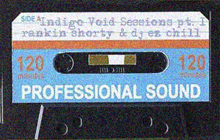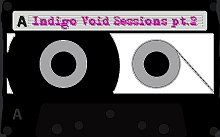
This last episode of Kandinsky's dubb teachings is again about the spatial tricks Kandinsky used, and about connections between spatial fx in paintings and spatial fx in music, especially dub. We can see that most paintings have a virtual kind of space, like a 3D illusion. In music there's something similar going on. But what is musical space?

In the acoustic era (the times when there were no speakers and amps) music was mostly about live performance. Then, the invention of electronic sound, records, tape recorders etc. gave us virtual acoustics (artifical reverb, tape echo etc.) and even immersion in 'surround' sound. These techniques are really new musical elements. Just listen to any piece of music and switch from stereo to mono. The difference is space, and if the sound quality is good, the difference between mono and stereo sound can be quite dramatic.
Composers like Karlheinz Stockhausen started to research the possibilities of virtual space and virtual acoustics back in the sixties, but looking at the 20th century, King Tubby was probably the most influential producer of 3D 'space-music'.
In the previous episode we saw some techniques Kandinsky used to create depth in a painting. New ideas that replaced the perspective trick, not unlike creating depth in a music recording using just eq and filters. But there are even more ways to create space, depth and ambience in music, besides using eq, filters, and obvious tools like reverb or echo (the last two being the classic spatial 3D tools).
So-called spatial enhancers are used to create an extra wide 3D/stereo impression. These tools are used all the time, especially in games, cinema and high end music productions. Nowadays spatial enhancers are also 'embedded' in cheap audio equipment.
Spatial enhancers are based on psycho-acoustic tricks that process and mix up the sounds going to the left and right speakers. There are various techniques like M/S, early reflections, ping pong delay and the addition of out-of-phase sound. Sound engineers may also know about the Haas effect or an oldskool thing called sonic holography.

Personally i don't like these tricks because the sound becomes less tight, it blurs the stereo image and it can sound hollow and artificial if it's applied too generously to a whole mix. On the cheapest type of speakers the extra wide sound may seem to make a system sound a little more expensive but if you listen carefully you'll notice that it only works if you're at an exact equal distance between the speakers.

Surround sound is another way to immerse yourself in sound. You might think that this is perfect for dub, but most dub producers are not that exited about it. The biggest problem is that even in the case of stereo most people are clueless about proper speaker placement, and this problem gets much worse with 5.1 surround.
The other problem is that the 5.1 system is designed for Hollywood-type cinema (eek! dinosaurs behind me) and not for music. It can place the sounds around you in a warped kind of circle but the sounds can't really do any new tricks (how about moving up/down for a change) and they can never come closer to your ears than the distance to the speakers.

In the last 20 years many new and revolutionary techniques have been invented for 3D sound but unfortunately 5.1 is not that good. For the music industry it's just another excuse to sell you a new edition of the Beatles' White Album. If you want to experience an immersive type of sound you have to get esoteric: binaural spatial synthesis, wave-field synthesis, holophonics, transaural audio.
Let's go back to painting because the spatial enhancement trick is also used by abstract painters sometimes. The huge red painting by Barnett Newmann titled Vir Heroicus Sublimis is a good example.
Newmann wanted the audience to stand very close to the painting so they would be immersed in red. The idea was to experience a right here right now kind of feeling, so intense that you and the painting become one in a mystical kind of way. A bit contrived if you ask me, not unlike the extra wide button on a cheap stereo set.
 Mark Rothko's Houston Chapel is an example of abstract 'surround' painting. Rothko also wanted an immersive experience.
Mark Rothko's Houston Chapel is an example of abstract 'surround' painting. Rothko also wanted an immersive experience. "I shall never forget the great wooden houses covered with carvings. In these magical houses I experienced something I have never encountered again since. They taught me to move within the picture, to live in the picture. I still remember how i entered the living room for the first time and stood rooted to the spot before this unexpected scene. The table, the benches, the great stove (indispensable in Russian farmhouses), the cupboards and every other object were covered with brightly colored, elaborate ornaments. (...) When I finally entered the room, I felt surrounded on all sides by painting, into which I had thus penetrated."
Wassily Kandinsky - from 'Reminiscenses'

Kandinsky must have really liked his 'immersive' experience in the Russian farmhouse, but except for some murals perhaps, i don't think he ever tried to recreate this in his art. He didn't use tricks like super size painting or surround painting but he did try some other spatial tricks that are quite clever.
As you can see in paintings like 'Hommage to Grohmann' the layering of the various elements is often a bit ambiguous. It's hard to tell which elements of the painting are in front or in the back and the order of the layers changes in all kinds of funny ways, like the result of some weird layer effect in Photoshop. You can't really tell if you're looking at the objects from the side or from the top. It's not an optical illusion, but definitely confusing enough to keep your mind busy in a pleasant way. You won't notice these effects if you only look at a painting for 2 seconds, but if you give it time and travel over the whole surface following the lines, shadows, fake perspectives and other little tricks you'll be amazed. At the same time you should keep in mind that nowadays we're used to much more hi tech spatial effects, so keep in mind that this was state of the art 100 years ago.
I think the connection with dub music is quite easy to make. The movements, the sometimes shocking colors and the confusing but at the same time exiting use of plastic spatial effects is what King Tubby, Scientist and Mad Professor do all the time.

Official scientists have found that unlocalized sounds trigger anxiety or a heightened state of arousal. This has to do with survival of course. But dub scientists found that mixing up all kinds of localization cues like reverb, echo etc. in funny ways causes even more arousal :-)
The official dub professor Michael E. Veal speculates in his book titled 'Dub' that
"suffusing their music with the sensation of echo during a period when the symbol of Africa was being consciously revitalized in diasporic consciousness, the creators of dub managed to evoke a cultural memory of ancestral African roots through heavy use of the reverb and echo effects and various musical strategies of African origin."
This may all be true but these effects also make an average tune sound more exiting, bigger, louder, dreader and so on :-) Don't get me wrong. The last thing i'd want to do is to put down academics. In fact here's a list of books and academic studies about Kandinsky.
















